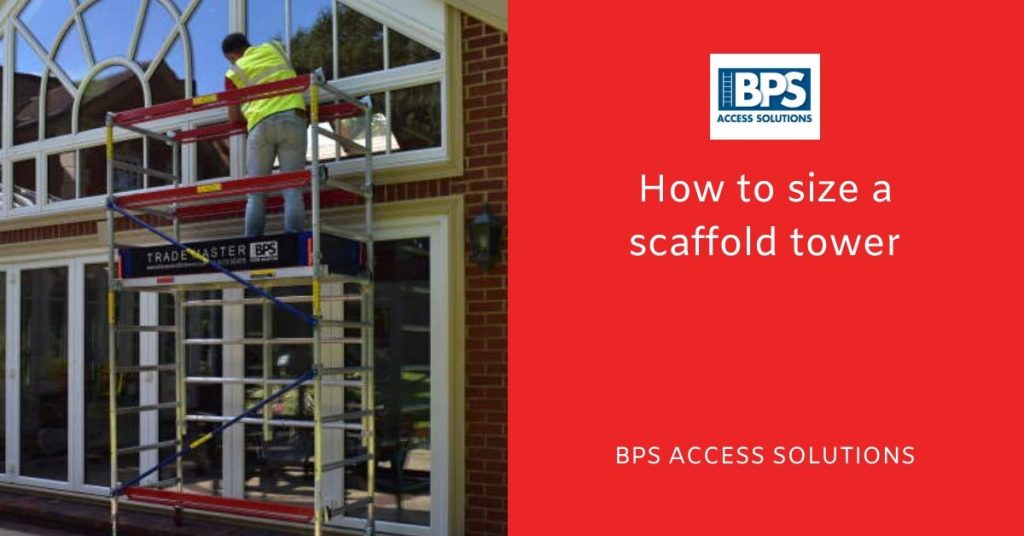How tall do I need my scaffold tower? / How to size a scaffold tower
For many professionals the scaffold tower is one of the most important pieces of equipment they use at work. Scaffold towers have developed as a more suitable, practical alternative to ladders in many situations. Not only are scaffold towers generally stronger and more stable, they can also be used to provide a safe working platform at greater heights than conventional ladders.
But what sort of considerations should be taken into account when preparing a scaffold tower for a work site, whether that’s in the home or in a commercial setting? If you haven’t set up or used a scaffold tower before, you probably won’t know exactly what to consider beforehand, so we’ll run through the process below.
Assessing the work site
Before you set up a scaffold tower, the first thing to assess is the work site you will be working on. The floor surface of the work site forms the foundations of the scaffold tower, so it’s vital that you check it is stable enough to support the weight of a loaded scaffold tower. If the floor is uneven, the risk of the tower losing balance and anyone working on it suffering a dangerous fall is massively increased. Various obstacles can also significantly increase the risk of an accident.
Indoor and outdoor work sites also come with different considerations for the user and the way in which the scaffold tower should be set up. Indoor work sites generally contain fewer obstacles and potential hazards. Outdoor work sites, on the other hand, come with extra factors such as adverse weather conditions and potential hazards like heavy machinery.
Where will you be carrying out the work?
Once you know which type of work site on which you will be using the scaffold tower to carry out work, you need to work out which specific places you will need to access. For example, carrying out work three quarters of the way up a three metre wall is very different to carrying out work on a five metre ceiling. Obviously, the lower down you will be working, the lower the scaffold needs to be. The type of tools you will be using will also make a difference to how you set up a scaffold tower, as some tools are much heavier and more cumbersome than others.
Setting up the scaffold tower
Having considered the surface and the position of the work site you will be using the scaffold tower on, it’s finally time to set the structure up. This part of the process is much easier and more efficient with more hands ready to help out. With all but the smallest mobile scaffold towers, you must have at least two people assembling the scaffold tower to ensure the process is as safe as possible. Some mobile scaffold towers have wheels at the base of each leg which allow them to be moved around much more easily without having to be lifted into place. Once you have moved your mobile scaffold tower into the right position, all you need to do is lock the wheels in place. Standard scaffolding towers, on the other hand, need to be manually lifted into position each time they are moved. This can be tricky because, depending on the height of the scaffold tower, they are much harder to lift into position, and some may have to be almost fully dismantled before this can be done.
As previously mentioned, the height of the work site is the most important consideration when it comes to determining the height of the scaffold tower. To ensure a safe working environment for the worker on the tower and anyone else on the ground, you need to ensure that the work site is well within arms reach whilst using the relevant tools and equipment. Measuring the height of the work site beforehand will allow you to build the scaffold tower to the right specifications. As you build the tower upwards towards the wall or ceiling you will be working on, each level should be added from the inside of the tower as you move upwards. This way, the sides of the scaffold tower structure help protect workers from falls and also ensure working platform components do not accidentally fall.
Class 3 scaffolding towers, for example, are safe to be erected up to a height of seven metres in either indoor or outdoor work environments. If you are using one of these scaffold towers on a work site, even a small difference in the floor surface can translate to a significant pitch at the top of the scaffold tower. To make small alterations to the level of the scaffold tower’s working platform, use the adjustable legs to fine tune each corner. Additionally, with high scaffold towers, extendable support legs should be installed at each corner to increase the scaffold tower’s base width.
When it comes to sizing a scaffold tower, the most important consideration is the workers who will be using it. As long as they have the right conditions to carry out their task safely and efficiently, sizing a scaffold tower is reasonably simple.
If you would like to know more about the range of scaffolding towers and other height access solutions we supply, please get in touch today.
No related posts.



